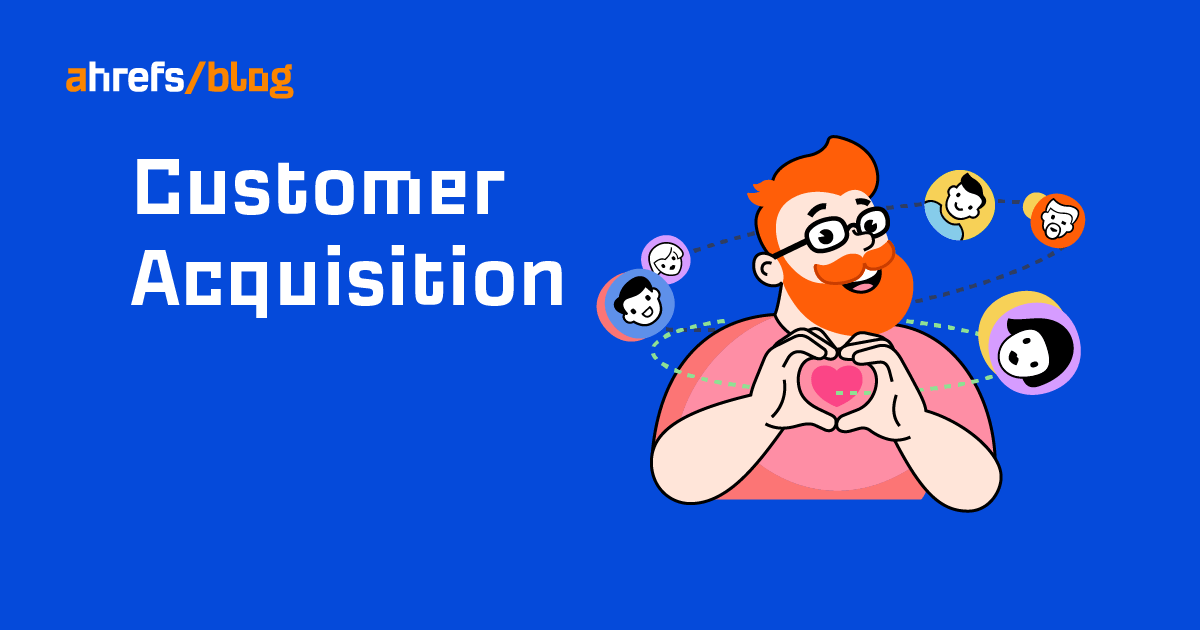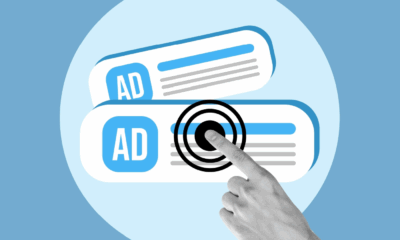SEO
The Essential Guide to Customer Acquisition

Customers are the lifeblood of any business.
Without new customers, businesses cannot survive, let alone grow.
In this guide, you’ll learn how to acquire more new customers for your business.
Here’s what we’ll cover:
Customer acquisition is the process of gaining new customers for a business.
Customer acquisition is not a “one-step” process. Most prospects don’t turn into customers instantly. Instead, they follow a journey:
- Awareness – The buyer realizes they have a problem. They want to understand more about it.
- Consideration – The buyer is looking for and comparing potential solutions to their problem.
- Decision – The buyer purchases a solution.

So, in order to acquire new customers, you need to align your marketing with these three stages.
- Awareness – You need to appear in the consciousness or awareness of your potential customers. You’ll also need to show them your product or service can help to solve their problem.
- Consideration – You need to convince these prospects that they should choose your product or service.
- Decision – You need to “tip” these prospects over the finishing line. Common tactics include discounts and free trials.
Customer acquisition isn’t about executing a variety of tactics and hoping one sticks. You need a strategy, i.e., your battle plan. This is how you’re going to attract new customers and choose the right acquisition tactics.

Here’s how to create a customer acquisition strategy.
1. Identify your customers and where they hang out
If you don’t know who your customers are, you can’t attract more of them to your business.
That’s why the first step of your customer acquisition strategy is to figure out who your ideal customers are.
If you’ve done your market research and created customer personas, then this should be easy. You’ll already know who you’re trying to reach.
For example, here’s a simplified version of our ideal customer at Ahrefs:
SEO professionals and website owners who want to drive more traffic to their websites.
If you’re still in the early stages and don’t have a customer statement like this yet, don’t worry. You can use this guide to create one for your business.
Knowing who your ideal customers are will also help you figure out which marketing channels you should use. For example, we know website owners who desire more traffic are often searching on Google and looking for helpful guides.
This is one of the main reasons why SEO-driven content marketing is our main marketing tactic.
Experienced SEOs tend to hang out a lot on Twitter too, and that’s why we have a heavy presence there.
2. Set your goals
For your strategy to work, you need to know your destination. That is your goal.
Ideally, you should have goals for each stage of the buyer’s journey. But in reality, most companies have limited manpower, time, budget, and resources. So attempting to achieve goals for each stage may prove to be difficult.
In that case, you’ll have to prioritize. I suggest focusing on the area where you’re lacking the most currently.
For example, perhaps you may have a lot of traffic coming to your website (awareness). Yet you aren’t seeing any substantial increase in your sales (purchase). As such, you may want to set a goal and tackle the “problem area.”
Once you’ve identified what you want to work on, you should set a SMART objective to make it clear what it is you want to achieve.
- Specific – It should clearly state the desired outcome.
- Measurable – It should be something you can track the success of.
- Achievable – It should be realistic.
- Relevant – It should align with your overall business objectives.
- Timely – It should have a time frame attached to it.
For example, this is a good objective aligned with the SMART criteria:
Increase the conversion rate of your free trial to a paid subscription from 1% to 3% in the next 12 months.
3. Choose your customer acquisition channels
Based on what you’ve designed so far in your strategy, you should have an idea of which channels may work best to acquire new customers.
Pick one to two of the most suitable ones and begin experimenting with them. (More about the different channels in the next section.)
Here are some of the most popular customer acquisition channels you can experiment with for your business.
1. Search engine optimization (SEO)
SEO is the practice of optimizing a website or webpage to increase the quantity and quality of its traffic from a search engine’s organic results.
Pros
- Passive, organic (almost free) traffic
- Evergreen and compounding effects; article written a few years ago can still generate traffic if it ranks high on the search engines
- Potential customers are automatically qualified by their search intents, e.g., someone searching “ahrefs vs moz” is closer to buying than someone searching “how to increase website traffic”
- SEO content can influence entire marketing funnel
Cons
- Ranking high on search engines takes time
- Popular terms can get competitive (i.e., lots of time and resources required)
- Return on investment (ROI) can be difficult to measure
- Slower effects for newcomers; website with smaller number of high-quality backlinks and low topical authority may find it tougher to rank higher in the beginning stages
2. Content marketing
Content marketing is the process of creating and distributing content to attract and retain customers.
Pros
- Educates potential customers
- Builds loyalty and retention
- Can go viral in the short term and create a lot of attention and awareness at once
- Builds credibility
- Can be the basis of other marketing channels (e.g., digital advertising)
Cons
- ROI can be difficult to measure
- Requires time to work
- Content needs to be promoted and distributed; otherwise, attention may be scarce
- Content must be high quality; otherwise, it can’t stand out from the tons of other published content
3. Digital advertising
Digital advertising is the process of paying a website or platform to reach its audience via ad space.
Pros
- Fast way to get traffic; just set up an ad and get it running in a matter of minutes
- Highly specific targeting (geography, age, gender, interests, etc)
- Easy to measure and scale
Cons
- Can be expensive (especially when scaling up)
- Learning curve exists; costs time and money to figure out what works for your exact business
- Suffers from symptoms like ad fatigue and banner blindness
- Increasing use of ad blockers and third-party cookies blocking by web browsers may affect measurement and effectiveness
4. Influencer marketing
Influencer marketing is the practice of working with influencers—people who have an active, sizable audience—to promote your brand’s message, products, or services.
Pros
- Good way to improve brand awareness
- Popular influencers can “bestow” a halo effect on your brand
- Can generate direct sales, e.g., via influencer-specific discount codes
Cons
- ROI can be difficult to measure
- No guaranteed returns when working with influencers
- Risk of unwanted brand associations if you work with the wrong person
- Limited control over creative or messaging
5. Email marketing
Email marketing lets you reach your prospects’ mailboxes with messages that either prompt direct action or aim to encourage prospects to create a long-term relationship with the brand.
Pros
- Easily reach your prospects or customers directly (and at any time)
- Emails sent can be highly personalized and segmented
- Easy to measure
Cons
- Takes time to organically build a quality email list
- Overdoing it can cause you to break email marketing legislation (GDPR, CAN-SPAM, etc)
- Can be competitive (people’s inboxes are flooded with emails!)
6. Video marketing
Video marketing is the process of creating and distributing video content to attract and retain customers.
Pros
- Great for demonstrating how a product works
- Can be later repurposed into other content formats (e.g., your script can be turned into a blog post; main video can be turned into multiple, bite-sized versions)
- Engaging videos can capture and retain attention much more effectively than other formats
Cons
- Very resource-intensive to produce one high-quality video, let alone many
7. Social media
Social media drives traffic to your webpages and creates engagement with your brand by means of social media platforms.
Pros
- Organic, almost free traffic
- Massive audiences can be found on different social media platforms
- Can interact directly with your audience
Cons
- Not easy to build a following on social media
- Social media platforms may decrease your organic reach (to get more people to pay for ads)
- May be at “mercy” of these platforms; you can get banned or removed anytime, which means losing all your following
- May experience many negative comments and trolls
8. Referral programs
A referral program incentivizes existing customers to promote your brand to their family and friends.
Pros
- Can be a low-cost way to acquire new customers
- Builds customer loyalty
Cons
- No guarantees that a referral program will work
- Can’t “force” your customers to refer their friends
Here are some examples of how different businesses have acquired their customers.
1. Ahrefs – Content marketing
Ahrefs is an all-in-one SEO toolset that allows you to do keyword research, competitor analysis, website audits, content research, rank tracking, and more.
The main customer acquisition strategy we use at Ahrefs is SEO-driven content marketing. Here’s how we do it:
First, we find topics that our target customers are searching for on Google.
As mentioned earlier, our customers are often searching on Google for solutions to their problems. This makes SEO an ideal acquisition channel. Ranking high on Google also ensures that we get passive, organic traffic, as long as our content stays on top.

How do we find these topics?
- Go to Ahrefs’ Keywords Explorer
- Enter one or a few relevant keywords
- Go to the Matching terms report
- Switch to Questions

As you can see, there are over 180,000 topics to choose from. We’ll eyeball the list and note down those that are relevant to our customers.
Once we have a list of topics, we decide which topics to target first using business potential.

We start with topics that have a score of “3,” then “2,” and so on.
With a list of topics to work on, we create content based on this framework:
2. Circles.Life – Referral program
Circles.Life is a digital telco based in Singapore. Despite entrenched competition from the three existing major telcos in Singapore, Circles.Life has managed to succeed. (I, too, am one of its customers.)
One of the main ways it acquired its customers (at least in the early days) was via its referral program. In fact, according to HireDigital, over 40% of Circles.Life transactions come from referrals.

The success of a referral program depends on a few factors, but the main one is the incentive. An attractive incentive motivates customers to share; a bad one drives no action.
In this case, Circles.Life’s referral program succeeded because the prize was exactly what telco customers wanted: more data for low prices.
This is reminiscent of Dropbox’s referral program, which was also one of the main ways the cloud storage company acquired its first customers.
Recommended reading: How to Choose the Right Referral Incentives for Your Referral Program (With 20+ Examples!)
3. Luxy Hair – Video marketing
Luxy Hair is an online store that sells hair extensions and hair-related accessories. With over 3 million subscribers on YouTube, it’s killing it.

Luxy Hair makes videos that get thousands, if not millions, of views.

Each video features different ways of styling hair, taking care of it, and more. And each video—ding ding ding, you guessed it—features Luxy Hair’s own products.
The company then makes it easy for any viewer or subscriber to buy by including the relevant links in the video description.

Recommended reading: The Four-Part Formula That Got Luxy Hair 2.8 Million Subscribers on YouTube
Here are some frequently asked questions related to customer acquisition.
How do you calculate customer acquisition cost?
Customer acquisition cost (CAC) is the average amount of money you spend to acquire a single customer.
This is calculated by dividing your customer acquisition expenses by the number of acquired customers.
CAC = Total amount spent on marketing/Number of new customers acquired
For example, if you acquired 10 new customers after spending $1,000 on your marketing, your CAC would be $1000/10 = $100.
What is the average customer acquisition cost?
According to Shopify’s research, here are the average CACs by industry:
- Arts and entertainment: $21
- Business and industrial: $533
- Clothing, shoes, and/or accessories: $129
- Electronics and/or electronics accessories: $377
- Food, beverages, and tobacco products: $462
- Health and beauty: $127
- Home and garden: $129
Don’t take these benchmarks as gospel. These numbers are averages and can differ depending on your brand, exact market, average order value, and more. You should always relate your CAC to your own business.
Why is customer acquisition cost important?
Many businesses calculate the CAC because they want to lower it.
However, trying to reduce your CAC in isolation is not a good idea. Most of the time, reducing your CAC and being more effective in marketing don’t necessarily go hand in hand.
If your CAC is too low, you may actually be limiting your exposure and under-spending on your marketing activities. Your balance sheet may look good in the short term, but you may be missing out on substantial growth opportunities in the long term.
So, rather than strive to pay as little as possible, aim for marketing effectiveness.
To do this, you should use CAC in relation to your customer lifetime value (CLV). This is a metric that estimates how much money an individual customer will spend on your products or services.
Here’s how CLV is calculated:
Avg. order value x Avg. annual purchase frequency x Avg. customer lifespan
Take this into account, alongside your customer base growth and overall marketing effectiveness, when deciding if you should adjust your CAC.
Recommended reading: How to Use & Reduce Customer Acquisition Cost (CAC)
What is customer retention?
Customer retention happens after a customer is acquired. The goal of customer retention is to keep your customers with your brand for a long time.
This is because a loyal customer is more valuable to a business. Not only will they buy more (and buy more frequently), but new customers are also often more expensive to acquire.
Customer acquisition and customer retention are not mutually exclusive. Both are important to a business’s growth and survival and should exist at the same time.
Some marketers even argue that customer retention should actually take precedence over customer acquisition—after all, there’s no point filling a leaky bucket.
7. Focus on retention first, not acquisition.
Retention drives acquisition.
Retention gives you a competitive edge > Retention drives referral > referral drives word of mouth > word of mouth is a powerful acquisition channel.
Retention gives you MOAT to acquire more customers.
— Aazar Shad (@Aazarshad) July 12, 2021
Recommended reading: What Is Customer Retention? 11 Examples and Strategies to Retain Customers
How do you measure customer acquisition?
Besides CAC and CLV, which metrics should you measure?
This depends on the exact tactic you’re using. I recommend reading the guide below for a sample of the most important customer acquisition metrics you should be tracking.
Recommended reading: 25 Marketing Metrics You Should Consider Tracking
Final thoughts
If you want to acquire new customers on a consistent basis, you need a strategy. Create one and then execute only the tactics that move your business ahead.
Did I miss out on anything important about customer acquisition? Let me know on Twitter.



















You must be logged in to post a comment Login